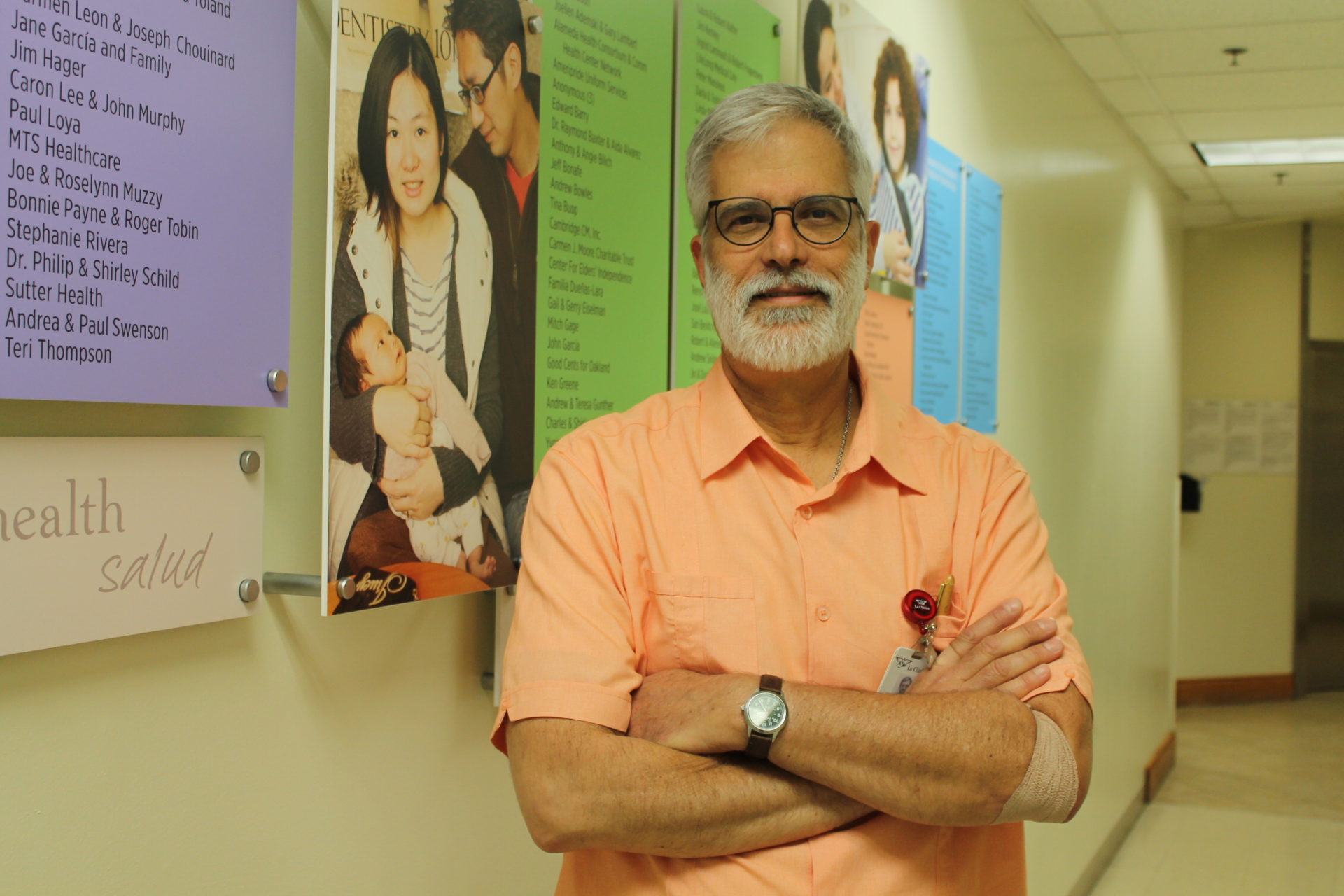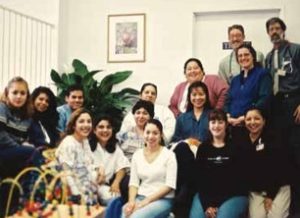
Dr. Pescetti is retiring this year after a professional career of more than 31 years in medicine. He served many roles at La Clínica during his 24 years here and took some time to provide a unique perspective of his work in the community.
INTERVIEWER: What drew you to La Clínica?
JOHN: I knew about La Clínica’s reputation when I was a resident at Children’s Hospital. I was doing my pediatrics residency, and it was pure serendipity and luck that got me here. I knew most of the pediatricians from La Clínica because they attended on some of the patients I took care of. They were really held in the highest regard by all the residents. They were known for their dedication and skill which they used to care for patients. As graduation approached, I saw Jim Eitel in the library who’d been a La Clínica pediatrician for more than 40 years. Jim mentioned to me that there would be an opening in pediatrics and if I wanted to apply. Before he said that, I didn’t know where I’d end up. I did apply for that opening, interviewed, and got it.
I did my residency in pediatrics. Also, the population was very important to me. I have lots of connections to Mexico, my wife is Mexicana. I spoke Spanish and being able to channel everything that I’d learn and all my experience in pediatrics to foster good pediatrics care in this community was my goal. I can’t imagine a better career or better vocation. My career at La Clínica was and still is very special. It has fulfilled me much more than I think I’ve ever brought to my patients and to the clinic. It’s been a great honor to have worked not only with the patients that I have had the opportunity to work with, but also my colleagues who are really top-notch. You couldn’t ask for a better group of people both colleagues and staff, just everybody: very moral, very upstanding, and very self-sacrificing. You just want to be around people like that.
INTERVIEWER: How was it like when you first started at La Clínica?
JOHN: La Clínica was relatively small then, I think our budget was around $9 million and about 100 employees at that time. The main pediatrics was at the 1501 [Fruitvale – Oakland]. At 1501, it was myself, Jim Eitel, and Peggy Payne. We had a small core of support staff: Antonio Rivera was the PA, we had a part-time pediatrician, one clerk in front, two MAs — Peggy and Pat, and an RN Sandra Camacho, who’s still here. I think we had maybe six exam rooms. We shared that building with Family Medicine and Medical Admin was upstairs, and Women’s clinic was next door.

2002 La Clínica Pediatrics at St. Joseph’s with Dr. John Pescetti (top right yellow tie); Dr. Jim Eitel (top right with eye glasses); Dr. Peggy Payne (top right in blue); and the Pediatrics support staff.
INTERVIEWER: What has made you stay for all these years?
JOHN: Number one, certainly the patients. I feel really attached to my patients, which made it really hard to finally end my clinical career here. They’re almost like family. That’s what’s really special about Latino culture; the definition of who the family is opens up a lot. A lot of people become part of your family, and I felt there were a lot of families that were wrapped around me that way. That has been very wonderful. Of course, the other thing has been my staff and colleagues. As I’ve said before, I think they are wonderful people, dedicated to doing the job we do. A lot of the providers and support staff could earn more money elsewhere but they choose to stay. I think people stay because of the internal reward of being part of the mission of La Clínica. It’s great to work with that group; that’s what’s kept me going for 24 years.
INTERVIEWER: What life lessons have you learned throughout the years at La Clínica?
JOHN: Certainly, there’s a lot about medicine and you do want to do a good clinical job. You can be the nicest person in the world but if you misdiagnose or screw up somehow, that’s not so good. One of the things you’re always trying to do as a provider is continue to increase your skills, knowledge base, and experience, so that when the next patient comes along, you’ll do a better job. In a broader sense of life, if you’re open and honest as a person with your patients and your colleagues, then you end up doing the right thing, which sometimes is not easy. There are times where it would be easier to cut corners or put your self-interest ahead of others. If you do the right thing, even if it’s hard, you end up getting rewarded. You make that whole interaction with patients and colleagues much more positive. You learn to look over the short term gains for the longer and broader gains and situations. When you get older, you frankly get tired. It has been more than 31 years [as a provider] and it’s a lot of running around and ripping your hair out. Sometimes it’s easy to say I can’t be bothered or I’m just too tired. But you have to remember to do the right thing. In the end, it’s always the right decision to do. It’s probably easier to do that here, than to do it in other systems because your patients are so special to you.
“…that’s what’s really special about Latino culture; the definition of who the family is opens up a lot. A lot of people become part of your family…”
INTERVIEWER: Is there a situation or patient whose story has resonated with you?
JOHN: There have been very [medically] complex patients that I’ve taken care of. When patients have complex medical issues there’s no way to avoid those not becoming complex social issues as well. When things go wrong with your health, a lot of things go wrong with your life in general. I’ve had the great fortune of meeting families who have inspired me with their resilience, resourcefulness, and the depth of love for their children. One of the patients I don’t see now because he’s an adult had a single mom who managed 16–18 medications every day for her child. Never complained, never missed doses, always on top of what she needed to do for her son. She was wonderful and fantastic. There have been many others like her. I have also dealt with kids with complex heart diseases and complex GI [gastrointestinal] situations and it has been amazing to see their development and be an integral part of that. There are too many to mention. Those are the ones that will always stick with me.
INTERVIEWER: How did you get involved in the tattoo removal clinic and made it a service that La Clínica provides?
JOHN: We started tattoo removal in 2003, when I was Medical Director and was approached by Adriana Alvarez who was the Director of Project New Start. It is an Alameda County program that helps youth who were in gangs or had similar issues and had tattoos they wanted removed to get on with their lives. The program helped people advance themselves and positively impact their communities. There was one [tattoo removal clinic] at Highland Hospital, and Adriana said there are a number of clients at Highland Hospital who were patients at La Clínica. She asked me “If we get you a laser, would you be willing to learn and run a removal clinic?” We’ve been doing it now for 14 years, once every month. Older teens and adults certainly have different issues in life. It’s very different for me because it’s not pediatrics, but it has been rewarding and worthwhile doing as well. It’s nice being part of something that is of pure service, nothing is reimbursed and it’s all on a volunteer basis.
INTERVIEWER: How impactful is the tattoo clinic in transforming lives of patients?
JOHN: It’s not just burning off tattoos of patients. The program Project New Start that La Clínica is part of looks at other parts of their lives. The program provides clients mentorships, employment, rehabilitation to get them off drugs and legal services because some have issues with the judicial system. It’s been great to watch the transformation happen. Clients get excited about seeing [their tattoos] fade and see them go away. As a professional and a volunteer, one of the messages we impart to our clients is that they are worth our time. Hopefully it tells clients that we think they are valuable and want to reinforce the changes they want to make in their life. We do what we can to foster their transformation. It’s not just “I’m gonna take the ink out your skin.” Part of this effort is to support their life change. They’re great people when they come in and great people when they finish the program. No tattoo can come off in less than a year; some take two to three years.
INTERVIEWER: What comes next for you in retirement?
JOHN: You never know, so much is out of our control. I’m still doing tattoo removal, lab director and radiology person in the Fruitvale Transit Village Clinic. Serve as long as I can, but basically taking it easy. Spend more time with my wife; it’s my turn to take care of her. She spent 38 years in marriage taking care of me.
INTERVIEWER: Any other comments?
JOHN: It’s been a real privilege to work with everyone that I’ve worked with, including Jane García. To have one CEO during my whole career is remarkable. We established a good relationship when I was Medical Director and it lasts to this day. The whole agency from top to bottom is filled with people who deeply care about the work we do, and put that foremost in their goals and decision-making. It has been very special to be part of the La Clínica family. I’m thankful for all that experience. I’m very privileged to have worked with them, and the patients I’ve known over the years.
